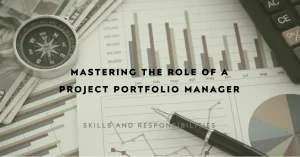I. Introduction
Hello there, fellow project portfolio management enthusiasts! Today, we’ll be diving into the fascinating world of project portfolio management. If you’ve ever felt overwhelmed by the sheer number of projects you’re juggling or struggled to align them with your organization’s strategic goals, then this blog post is for you.
Project portfolio management (PPM) can be a game-changer in the realm of project management. It’s all about efficiently managing and prioritizing projects so that you can achieve the greatest possible value from your portfolio. In this post, we’ll explore the core concepts of PPM, its significance in project management, and how it differs from project management itself. By the end, you’ll not only have a solid understanding of the basics, but you’ll also be equipped with real-life examples and best practices to help you excel in your own projects.
So, grab a cup of coffee (or tea, if you prefer) and let’s embark on this exciting journey together! We’ll start by discussing the core concepts of project portfolio management, which will provide a foundation for the rest of our discussion. Stay tuned, and let’s dive in!
II. Core Concepts of Project Portfolio Management
Alright, now that we’ve set the stage, let’s dig into the nitty-gritty of project portfolio management. Understanding the core concepts will help you grasp the essence of PPM and how it can elevate your project management game.
A. Definition and Key Elements
Project portfolio management is the centralized management of multiple projects or programs to achieve strategic business objectives. It involves selecting, prioritizing, and monitoring projects to ensure they are aligned with your organization’s goals and that resources are being used effectively. Think of it as the bird’s-eye view of your projects, enabling you to make informed decisions and drive success.
Some key elements of PPM include:
- Project selection: Ensuring that only projects with the highest potential for success are chosen.
- Prioritization: Ranking projects based on strategic importance, resource requirements, and potential return on investment.
- Resource allocation: Distributing resources, such as personnel, time, and budget, across your portfolio to optimize outcomes.
- Monitoring and reporting: Keeping an eye on project performance and sharing updates with stakeholders to enable informed decision-making.
B. Goals and Objectives
The primary goal of project portfolio management is to optimize the value of your project portfolio. It seeks to achieve this by:
- Aligning projects with strategic objectives
- Maximizing resource utilization
- Enhancing decision-making through data-driven insights
- Reducing risks and uncertainties
- Ensuring a balance between short-term and long-term initiatives
C. Benefits of Implementing Project Portfolio Management
If you’re still wondering why PPM is essential, let me share some of its amazing benefits with you:
- Improved strategic alignment: PPM helps ensure that your projects are in sync with your organization’s mission and vision.
- Enhanced decision-making: PPM provides the necessary data and insights to make informed decisions about which projects to pursue or discontinue.
- Better resource management: PPM allows you to allocate resources efficiently, ensuring that your most critical projects have what they need to succeed.
- Risk mitigation: By considering risks and uncertainties, PPM helps you proactively identify and address potential issues before they escalate.
- Increased flexibility and adaptability: PPM fosters a culture of continuous improvement, enabling you to adjust your portfolio as needed to respond to changing business conditions or new opportunities.
Phew! We’ve covered a lot in this section, but I promise it’s worth it. Now that we have a solid understanding of the core concepts of project portfolio management, let’s move on to discuss how it differs from project management and the unique role it plays in the world of projects.
III. Distinction between Project Management and Portfolio Management
As we continue our journey, it’s crucial to understand the difference between project management and portfolio management. While they may seem similar at first glance, they have distinct functions and purposes. Let’s break it down together!
A. Definition of Project Management
Project management is the practice of planning, executing, and controlling a single project to achieve specific objectives within a defined scope, timeline, and budget. It involves organizing resources, managing risks, and ensuring quality throughout the project lifecycle. Essentially, project management is all about delivering a successful project from start to finish.
B. Definition of Portfolio Management
Portfolio management, as we discussed earlier, is the centralized management of multiple projects or programs to achieve strategic business objectives. It involves selecting, prioritizing, and monitoring projects to ensure alignment with organizational goals, effective resource allocation, and risk mitigation. In other words, portfolio management is all about optimizing the value of your project portfolio as a whole.
C. Key Differences and How They Complement Each Other
Now that we know what project management and portfolio management are, let’s discuss their key differences and how they work together:
- Focus: Project management is focused on the successful completion of individual projects, while portfolio management is concerned with optimizing the value of the entire project portfolio.
- Perspective: Project management is task-oriented and emphasizes the details of executing a project, while portfolio management takes a higher-level, strategic view of the organization’s projects.
- Objectives: Project management aims to deliver a project within scope, time, and budget constraints, while portfolio management seeks to align projects with business objectives and maximize overall value.
- Decision-making: Project management decisions are typically made within the context of a single project, whereas portfolio management decisions are made based on the best interests of the entire organization.
These differences highlight the complementary nature of project management and portfolio management. By integrating these two disciplines, organizations can ensure that their individual projects are executed efficiently while also aligning their overall project portfolio with strategic goals. The result? A more successful, value-driven approach to managing projects.
With this newfound understanding of the distinction between project management and portfolio management, let’s explore the unique role that portfolios play in project management and see how it all comes together.
IV. The Role of Portfolios in Project Management
Having differentiated between project management and portfolio management, let’s dive deeper into the pivotal role that portfolios play in project management. By effectively managing your project portfolio, you can unlock the full potential of your projects and maximize the value they bring to your organization. Here’s how:
A. Aligning Projects with Strategic Goals
One of the most significant benefits of project portfolio management is that it helps ensure your projects are aligned with your organization’s strategic objectives. By carefully selecting and prioritizing projects based on their potential to contribute to these goals, you can create a more focused and coherent approach to project management. This alignment not only enhances the value of your projects but also increases the likelihood of achieving your organization’s long-term vision.
B. Resource Allocation and Prioritization
Resource constraints are an all-too-familiar challenge in project management. With limited time, budget, and personnel, it’s critical to allocate resources wisely to maximize their impact. Project portfolio management enables you to prioritize projects based on factors such as strategic importance, potential return on investment, and resource requirements. This prioritization ensures that your most crucial projects receive the resources they need to succeed, while less critical initiatives are scaled back or deferred.
C. Risk Management and Mitigation
Managing risk is an integral part of project management, but it becomes even more critical when dealing with multiple projects. Project portfolio management allows you to identify, assess, and mitigate risks across your entire project portfolio. By taking a holistic approach to risk management, you can proactively address potential issues before they escalate and minimize the impact of unforeseen events on your projects.
D. Performance Measurement and Improvement
To continuously improve your project management processes, it’s essential to measure performance and identify areas for improvement. Project portfolio management provides the tools and insights needed to track project performance and make data-driven decisions to optimize your portfolio. By regularly evaluating and adjusting your project management practices, you can drive ongoing improvement and deliver greater value to your organization.
Now that we’ve explored the critical role of portfolios in project management, let’s bring these concepts to life with some real-world examples. Stay with me as we dive into case studies that showcase the power of project portfolio management in action!
V. Real-life Examples of Portfolio Management in Project Management
Nothing beats a good story to help illustrate the concepts we’ve been discussing, right? So, let’s explore two real-life examples that showcase how project portfolio management can make a world of difference in the realm of project management.
A. Case Study 1: Successful Implementation of Portfolio Management
Imagine a rapidly growing software company that’s juggling multiple projects, including new product development, customer support initiatives, and internal process improvements. With so many projects in the pipeline, the company’s project managers were struggling to keep everything on track and ensure that resources were being used effectively.
To address these challenges, the company decided to implement a project portfolio management approach. They began by identifying their strategic objectives and assessing each project’s potential contribution to those goals. Next, they prioritized projects based on factors such as strategic importance, potential ROI, and resource requirements. This prioritization allowed them to allocate resources more effectively, ensuring that their most critical projects received the support they needed to succeed.
By adopting project portfolio management, the software company was able to improve the alignment of their projects with their strategic goals, optimize resource allocation, and enhance overall project performance. The result was a more focused, value-driven approach to project management that helped drive the company’s continued growth and success.
B. Case Study 2: Challenges Faced and Lessons Learned from Portfolio Management
Now, let’s look at a manufacturing company that decided to implement project portfolio management to better align their projects with their business objectives. Initially, they faced some challenges, including resistance to change, lack of clear communication, and insufficient training on the new processes.
Despite these obstacles, the company’s leadership remained committed to the success of their portfolio management initiative. They addressed the challenges by providing additional training, fostering open communication, and involving team members in the decision-making process. Over time, these efforts helped build buy-in and support for the new approach.
Through their perseverance and commitment to improvement, the manufacturing company was able to overcome the challenges and successfully implement project portfolio management. In the end, they achieved better strategic alignment, improved resource allocation, and more effective risk management, paving the way for continued success.
These real-life examples demonstrate the power of project portfolio management in driving more value-driven, strategic approaches to project management. By learning from these experiences and applying the principles of portfolio management in your own projects, you can unlock the full potential of your project portfolio.
As we wrap up our journey, let’s discuss some best practices for implementing project portfolio management to help you succeed in your own projects.
VI. Best Practices for Implementing Project Portfolio Management
You’ve made it this far, and I’m sure you’re eager to put these concepts into practice! Before you embark on your project portfolio management journey, let’s discuss some best practices to help you navigate the road ahead and set yourself up for success.
A. Developing a Portfolio Management Strategy
Start by defining a clear portfolio management strategy that aligns with your organization’s strategic objectives. This strategy should outline your approach to project selection, prioritization, resource allocation, and performance measurement. Having a well-defined strategy will provide a solid foundation for your portfolio management efforts and ensure that everyone is on the same page.
B. Ensuring Effective Communication and Collaboration
Effective communication and collaboration are crucial to the success of your portfolio management initiative. Make sure to involve relevant stakeholders in the decision-making process and keep them informed about the progress and performance of your projects. Establishing regular communication channels, such as status meetings and progress reports, can help facilitate transparency and foster a collaborative environment.
C. Leveraging Technology and Tools
Technology can be a powerful ally in your project portfolio management efforts. Consider using project portfolio management software or tools to help you track project performance, manage resources, and make data-driven decisions. These tools can streamline your processes, improve visibility, and enable more efficient portfolio management.
D. Continuously Evaluating and Improving Portfolio Management Processes
Project portfolio management is an ongoing process that requires continuous evaluation and improvement. Regularly assess the effectiveness of your portfolio management practices and identify areas for improvement. This may involve adjusting your project prioritization criteria, refining your resource allocation processes, or enhancing your risk management strategies. By fostering a culture of continuous improvement, you can ensure that your portfolio management approach remains agile and responsive to your organization’s evolving needs.
VII. Conclusion
Congratulations on reaching the end of our journey through the world of project portfolio management! By now, you should have a solid understanding of the fundamentals, the importance of portfolios in project management, and how to implement best practices in your own projects.
As you move forward, remember that the key to successful project portfolio management lies in aligning your projects with your organization’s strategic goals, effectively allocating resources, and continuously evaluating and improving your processes. By applying these principles and leveraging the power of portfolio management, you can unlock the full potential of your project portfolio and drive your organization toward greater success.
So go forth, my fellow project portfolio management enthusiasts, and embrace the exciting world of project portfolio management! I wish you the best of luck in your endeavors, and I look forward to hearing about your successes in the future.
To find out how Artificial Intelligence is changing the Project Management landscape, you have enjoy reading this article https://www.shaunstoltz.com/did-artificial-intelligence-just-change-everything-about-project-management/
Find out more about Shaun Stoltz https://www.shaunstoltz.com/about/
This post was written by an AI and reviewed/edited by a human.



